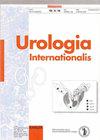Computed Tomography Renal Volumetry Better Predicts Postoperative Donor Renal Function in Live Kidney Donor Transplantation than Renal Scintigraphy: A Comparative Study
IF 1.5
4区 医学
Q3 UROLOGY & NEPHROLOGY
引用次数: 0
Abstract
Introduction and objectives: Both computed tomography (CT) and renal scintigraphy (RS) have been used to assess vascular anatomy, renal status, and split renal function (SRF). In this study, we used a recently developed software that facilitates renal volumetric evaluations to compare RS and automated CT volumetry for assessing residual renal function, and thus estimating postoperative renal function after donor nephrectomy. Methods: Fifty-one cases of donor nephrectomy were analyzed. Residual renal function was estimated based on RS and CT volumetry. The correlation between the postoperative estimated glomerular filtration rate (eGFR) and expected SRF, measured using RS and three types of CT volumetry data (ellipsoid, thin-slice, and 5-mm slice data), was determined. Results: The correlation coefficient between actual eGFR and expected SRF were significantly associated at each time point and modality (p<0.0001). At any time point, the difference in correlation coefficient between RS and 5-mm volumetry was significant (p-value: 0.003-0.018), whereas the differences in correlation coefficients between RS and the tri-axial volume calculation, and the tri-axial volume calculation and 5-mm volumetry, were generally statistically insignificant. Conclusions: Expected SRF was estimated more accurately by CT volumetric calculations (especially 5-mm-slice-based volumetry) than RS.计算机断层扫描肾脏容积测量比肾脏闪烁成像更能预测活体肾脏捐献移植的术后捐献者肾功能:比较研究
简介和目的:计算机断层扫描(CT)和肾闪烁成像(RS)已被用于评估血管解剖、肾脏状态和分裂肾功能(SRF)。在这项研究中,我们使用了一种最新开发的肾脏容量评估软件来比较RS和自动CT容量法评估残余肾功能,从而评估供肾切除术后的肾脏功能。方法:对51例供肾切除术进行分析。根据RS和CT容积法估计残余肾功能。术后估计肾小球滤过率(eGFR)和预期SRF之间的相关性,使用RS和三种类型的CT体积测量数据(椭球、薄层和5mm层数据)进行测量。结果:实际eGFR与预期SRF的相关系数在各时间点和模式下均显著相关(p<0.0001)。在任何时间点,RS与5-mm容积法的相关系数差异均有统计学意义(p值为0.003 ~ 0.018),而RS与三轴容积法、三轴容积法与5-mm容积法的相关系数差异均无统计学意义。结论:CT体积计算(尤其是基于5mm切片的体积测量)比RS更准确地估计预期SRF。
本文章由计算机程序翻译,如有差异,请以英文原文为准。
求助全文
约1分钟内获得全文
求助全文
来源期刊

Urologia Internationalis
医学-泌尿学与肾脏学
CiteScore
3.30
自引率
6.20%
发文量
94
审稿时长
3-8 weeks
期刊介绍:
Concise but fully substantiated international reports of clinically oriented research into science and current management of urogenital disorders form the nucleus of original as well as basic research papers. These are supplemented by up-to-date reviews by international experts on the state-of-the-art of key topics of clinical urological practice. Essential topics receiving regular coverage include the introduction of new techniques and instrumentation as well as the evaluation of new functional tests and diagnostic methods. Special attention is given to advances in surgical techniques and clinical oncology. The regular publication of selected case reports represents the great variation in urological disease and illustrates treatment solutions in singular cases.
 求助内容:
求助内容: 应助结果提醒方式:
应助结果提醒方式:


